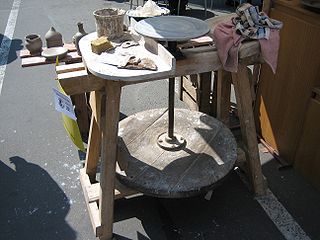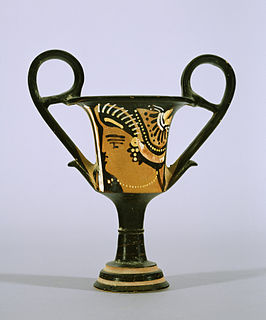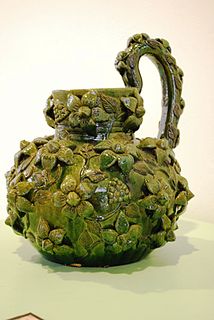
Pottery is the process and the products of forming vessels and other objects with clay and other ceramic materials, which are fired at high temperatures to give them a hard and durable form. Major types include earthenware, stoneware and porcelain. The place where such wares are made by a potter is also called a pottery. The definition of pottery, used by the ASTM International, is "all fired ceramic wares that contain clay when formed, except technical, structural, and refractory products." In art history and archaeology, especially of ancient and prehistoric periods, "pottery" often means vessels only, and sculpted figurines of the same material are called "terracottas".

Cookware and bakeware is food preparation equipment, such as cooking pots, pans, baking sheets etc. used in kitchens. Cookware is used on a stove or range cooktop, while bakeware is used in an oven. Some utensils are considered both cookware and bakeware.

Grooved ware is the name given to a pottery style of the British Neolithic. Its manufacturers are sometimes known as the Grooved ware people. Unlike the later Beaker ware, Grooved culture was not an import from the continent but seems to have developed in Orkney, early in the 3rd millennium BC, and was soon adopted in Britain and Ireland.

In pottery, a potter's wheel is a machine used in the shaping of round ceramic ware known as clay. The wheel may also be used during the process of trimming the excess body from leather hard dried ware, and for applying incised decoration or rings of colour. Use of the potter's wheel became widespread throughout the Old World but was unknown in the Pre-Columbian New World, where pottery was handmade by methods that included coiling and beating.

Ancient Greek pottery, due to its relative durability, comprises a large part of the archaeological record of ancient Greece, and since there is so much of it, it has exerted a disproportionately large influence on our understanding of Greek society. The shards of pots discarded or buried in the 1st millennium BC are still the best guide available to understand the customary life and mind of the ancient Greeks. There were several vessels produced locally for everyday and kitchen use, yet finer pottery from regions such as Attica was imported by other civilizations throughout the Mediterranean, such as the Etruscans in Italy. There were a multitude of specific regional varieties, such as the South Italian ancient Greek pottery.

Native American pottery is an art form with at least a 7500-year history in the Americas. Pottery is fired ceramics with clay as a component. Ceramics are used for utilitarian cooking vessels, serving and storage vessels, pipes, funerary urns, censers, musical instruments, ceremonial items, masks, toys, sculptures, and a myriad of other art forms.

A kantharos or cantharus is a type of ancient Greek cup used for drinking. Although almost all surviving examples are in Greek pottery, the shape, like many Greek vessel types, probably originates in metalwork. In its iconic "Type A" form, it is characterized by its deep bowl, tall pedestal foot, and pair of high-swung handles which extend above the lip of the pot. The Greek words kotylos and kotyle are other ancient names for this same shape.

Hopewell pottery is the ceramic tradition of the various local cultures involved in the Hopewell tradition and are found as artifacts in archeological sites in the American Midwest and Southeast. The Hopewell were located around the Mississippi and Illinois Rivers during the Middle Woodland Period, and the Hopewell Interaction Sphere spanned from the Gulf of Mexico to Ontario, Canada.

Minoan pottery has been used as a tool for dating the mute Minoan civilization. Its restless sequence of quirky maturing artistic styles reveals something of Minoan patrons' pleasure in novelty while they assist archaeologists in assigning relative dates to the strata of their sites. Pots that contained oils and ointments, exported from 18th century BC Crete, have been found at sites through the Aegean islands and mainland Greece, on Cyprus, along coastal Syria and in Egypt, showing the wide trading contacts of the Minoans.

Maria Montoya Martinez was a Native American artist who created internationally known pottery. Martinez, her husband Julian, and other family members, including her son Popovi Da, examined traditional Pueblo pottery styles and techniques to create pieces which reflect the Pueblo people's legacy of fine artwork and crafts. The works of Maria Martinez, and especially her black ware pottery, survive in many museums, including the Smithsonian, the Metropolitan Museum of Art, the Denver Art Museum, and more. The Penn Museum in Philadelphia holds eight vessels – three plates and five jars – signed either "Marie" or "Marie & Julian".
A pinch pot is a simple form of hand-made pottery produced from ancient times to the present. The pinching method is to create pottery that can be ornamental or functional, and has been widely employed across culture. The method used is to simply have a lob of clay, then pinch it to the shape desired.

Bucchero is a class of ceramics produced in central Italy by the region's pre-Roman Etruscan population. This Italian word is derived from the Latin poculum, a drinking-vessel, perhaps through the Spanish búcaro, or the Portuguese púcaro.
This is a list of pottery and ceramic terms.

A profile gauge or contour gauge is a tool for recording the cross-sectional shape of a surface. Contour gauges consist of a set of steel or plastic pins that are set tightly against one another in a frame which keeps them in the same plane and parallel while allowing them to move independently, perpendicularly to the frame. When pressed against an object, the pins conform to the object. The gauge can then be used to draw the profile or to copy it on to another surface.

Green glazed pottery of Atzompa is a style of glazed pottery, which originates in the Oaxaca, Mexico town of Santa María Atzompa. Almost all of the pottery made here is of a jade-green color, due to the lead monoxide glaze which has been traditionally applied to it.

Mississippian culture pottery is the ceramic tradition of the Mississippian culture found as artifacts in archaeological sites in the American Midwest and Southeast. It is often characterized by the adoption and use of riverine shell-tempering agents in the clay paste. Shell tempering is one of the hallmarks of Mississippian cultural practices. Analysis of local differences in materials, techniques, forms, and designs is a primary means for archaeologists to learn about the lifeways, religious practices, trade, and interaction among Mississippian peoples. The value of this pottery on the illegal antiquities market has led to extensive looting of sites.

Mata Ortiz pottery is a recreation of the Mogollon pottery found in and around the archeological site of Casas Grandes (Paquimé) in the Mexican state of Chihuahua. Named after the modern town of Mata Ortiz, which is near the archeological site, the style was propagated by Juan Quezada Celado. Quezada learned on his own to recreate this ancient pottery and then went on to update it. By the mid 1970s, Quezada was selling his pottery and teaching family and friends to make it and the pottery was able to penetrate the U.S. markets thanks to efforts by Spencer MacCallum and later Walt Parks along with Mexican traders. By the 1990s, the pottery was being shown in museums and other cultural institutions and sold in fine galleries. The success of the pottery, which is sold for its aesthetic rather than its utilitarian value, has brought the town of Mata Ortiz out of poverty, with most of its population earning income from the industry, directly or indirectly.

Philippine ceramics refers to ceramic art and pottery designed or produced as a form of Philippine art.

Cord-marked pottery or Cordmarked pottery is an early form of a simple earthenware pottery made in precontact villages. It allowed food to be stored and cooked over fire. Cord-marked pottery varied slightly around the world, depending upon the clay and raw materials that were available. It generally coincided with cultures moving to an agrarian and more settled lifestyle, like that of the Woodland period, as compared to a strictly hunter-gatherer lifestyle.
Pottery of Sri Lanka is one of the traditional small industries. The pottery industry is distributed almost throughout the country and it has a long history and a tradition.


















